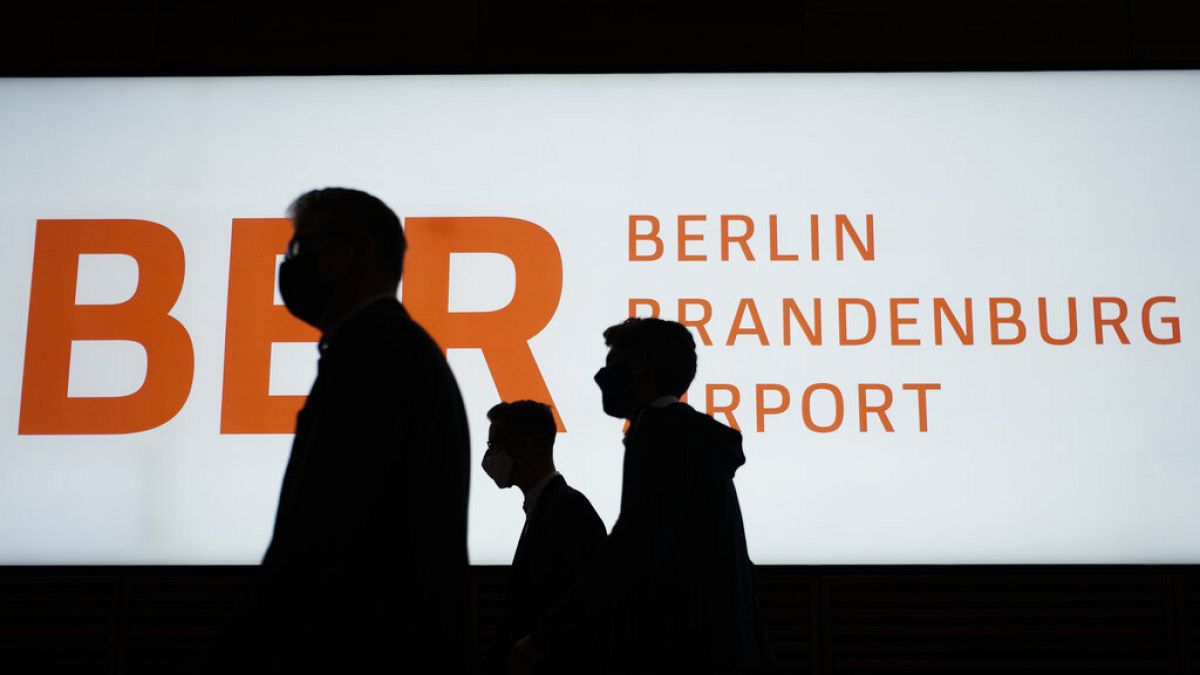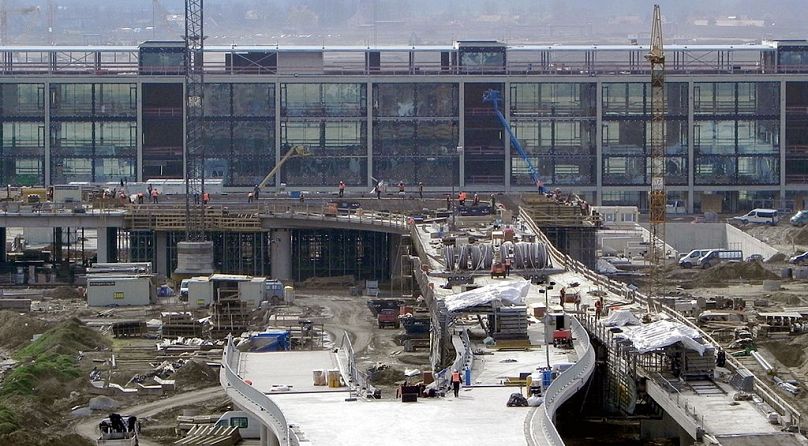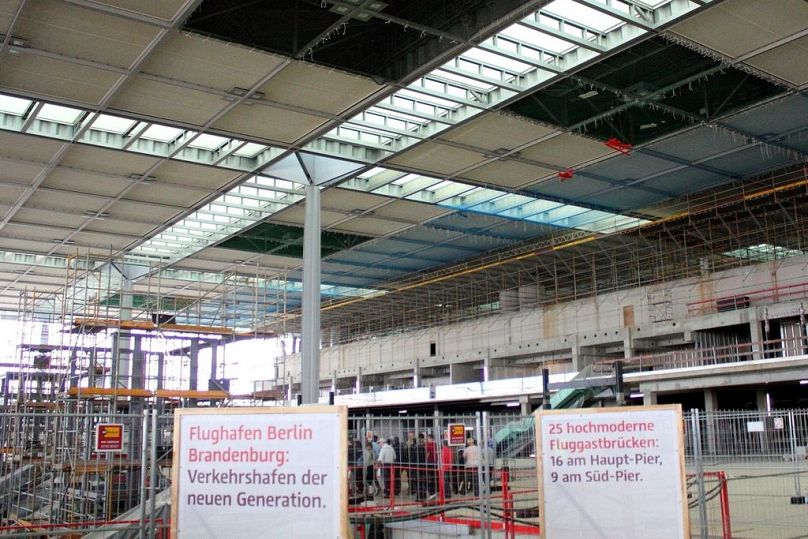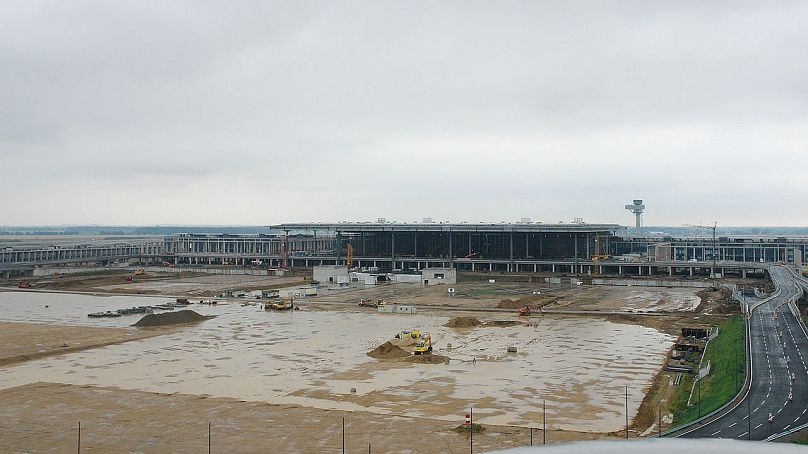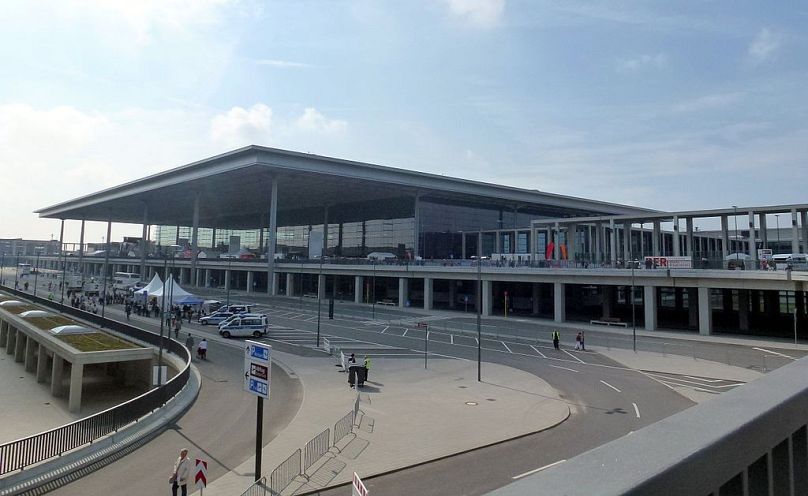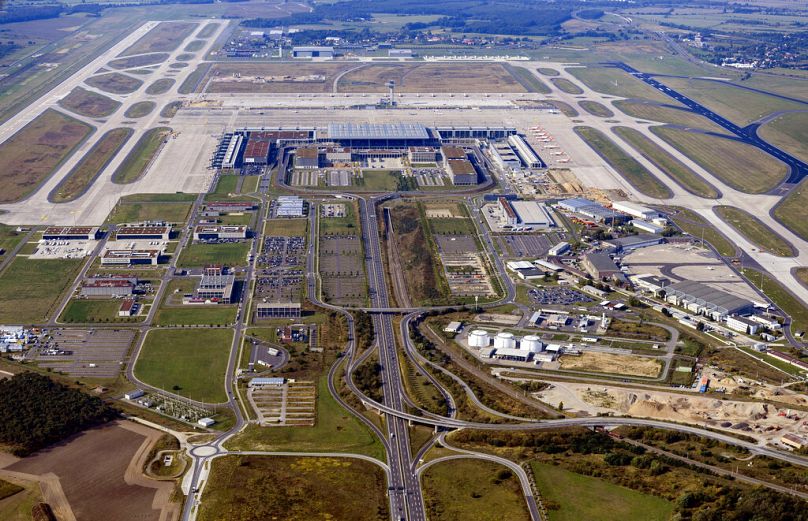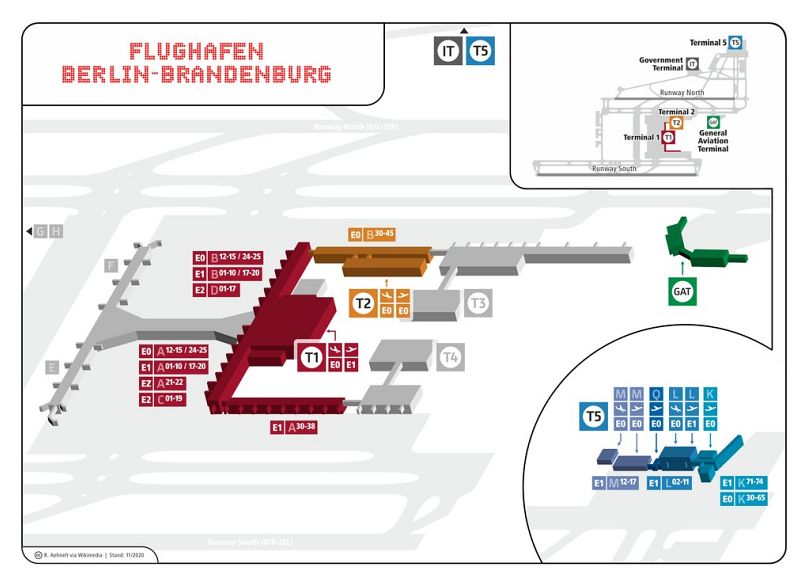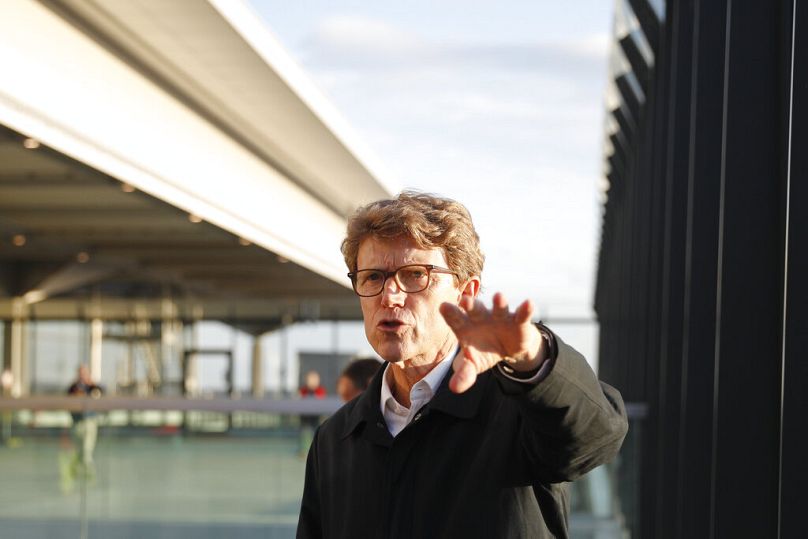The opening was initially scheduled for October 2011 but was then pushed back to October 2013, spring 2014, 2017, and the second half of 2018. It has finally opened its doors.
The saying "better late than never" has never been more apt than for Berlin's new airport which is finally opening — nearly 10 years behind schedule.
The Berlin Brandenburg Airport (BER), which continues its streak of luck by opening in the middle of a pandemic that has caused travel worldwide to plummet, was meant to open its door on October 30, 2011, but poor planning and construction work has delayed the project multiple times and inflated its cost to the tunes of billions of euros.
Euronews recaps the whole saga.
An idea is born
The idea of a central airport for the German capital emerged after the country's reunification in 1991 and planning began just one year later. The airport was initially to be named "Berlin Brandenburg International".
In 1996, the three shareholders — Berlin, the state of Brandenburg and the federal government — decided that "to meet regional demand" the airport would be built at Schönefeld, already the site of an airport.
For airport planner Dieter Faulenbach da Costa, that was the first mistake.
Faulenbach da Costa, who has been planning airports since 1985 and has accompanied the BER airport project as a consultant, says that even in the 1990s it was clear that the German capital would grow and that the Schönefeld area was too close to the city and wouldn't be expandable.
A 1994 regional planning procedure had already flagged the risk, concluding that the area was unsuitable for the planned two runways and an annual passenger volume of 30 million. It recommended the locations of Sperenberg, Jüterbog-Ost and Jüterbog-West, all located in the south of Brandenburg, but not bordering the capital.
Opening date: 30 October 2011
2003: The government and the federal states of Brandenburg and Berlin decide to build the airport themselves after long negotiations to privatise the airport construction and operation failed. The opening date was set for 30 October 2011.
September 5, 2006: The official construction of the airport begins with a ground-breaking ceremony.
2007: The Building Regulations Office of the Dahme-Spree district issues the permit for the main terminal and the "Pier North".
According to airport planner Faulenbach da Costa, "serious planning errors" already became obvious at this point. The terminal approved for construction, with a gross floor area of around 260,000 square metres and internal space allocation, was too small. Also, there was no general contractor appointed, instead, smaller construction contracts were given to various construction companies.
The shareholders and the architects' office (GMP and JSK) wanted to stick to the opening date "at any price", despite project managers at the time calling for a redesign of the airport and the postponing of the opening.
Instead, in order to advance with the construction work, a so-called "acceleration bonus" was awarded to building contractors — without any control over their success, says Faulenbach da Costa.
The architects were commissioned to plan the "South Pier" and to correct the planning errors discovered at the main Terminal 1.
Still, construction would eventually begin on the basis of the 2007 building permit.
For Faulenbach da Costa, the decision to proceed without making changes to the original plan despite the airport being too small in order to keep to the initial deadline was another mistake.
"They tried in a hurry to complete the terminal under pressure and caused chaos on the construction site, lost control of the construction site and then tried to finish no matter how. That is what led to the chaos," he argued.
Due to passenger capacity being too small, the decision is taken to extend the "Pier South" and the "Main Pier" and a new mezzanine floor is also to be included. This aimed at raising capacity to 27 million passengers per year, 12 million more than what was first planned.
2009: the airport is named after former German Chancellor Willy Brandt and its international name is changed to BER. In addition, two extension permits are granted for the South Pier (2009) and the pavilions (2010).
2010: the main engineering office responsible for technology planning files for insolvency. This causes turbulence in the airport's planning committee. In addition, new EU safety regulations require further construction measures at the airport.
That is what the official version says. But the media leaks that the building and security technology, as well as the fire protection measures in the terminal, have crucial flaws.
October 2011: there is no grand opening, instead it's pushed back to June 2012.
Opening date: 3 June 2012
April 2012: Weeks before the planned start of operations, Chairman of Supervisory Board Klaus Wowereit announces that the opening date has to be postponed. The fire protection system, infamously nicknamed "monster", does not operate due to a "lack of functionality".
Later, the State Court of Audit of Brandenburg revealed that the building was only 57 per cent completed at that time.
Lawsuits against the airport start being filed by local citizens and communities after the publication of the flight routes over aircraft noise and polluting emissions.
The Federal Administrative Court had already ruled six years earlier that no flight could take-off or land at the airport between midnight and 05:00 am.
When asked whether it would not have been better for the authorities to just cut their loses at this point, airport planner Faulenbach da Costa replied: "Formulated a bit exaggeratedly: A stick of dynamite would provide more order than trying to clean it up."
"What I meant was: Leave the shell of the building, strip the core of the building and rebuild everything inside. Keep the airport functional and, above all, meet the [passenger] demand. So that demand can still be met in 10-15 years' time. That would have been cheaper, faster and more successful than trying to renovate the building with the mess it had been made and then put it into operation 8 or 9 years later," he said.
June 2012: there is no grand opening, instead it's pushed back to March 2013.
Opening date: March, then October 2013
August 2012: Horst Amman, who oversaw the construction of a new runway and planning for Terminal 3 at Fraport, the main aviation hub in Frankfurt, is named COO. He begins to document building mistakes with their number reaching the six-digit range.
Apart from the well-known problem of the fire protection system, the escalators were too short, rainwater was leaking into the ventilation system, cable ducts were marked in places where there were pipes, many doors are wrongly numbered so that rescue services wouldn't be able to find the correct rooms, there are too few baggage carousels — the list is almost inexhaustible.
He calls for the opening to be postponed to October 2013.
March 2013: Hartmut Mehdorn, former boss of Deutsche Bahn and former head of AirBerlin, is appointed head of the airport and dismisses Amman.
He promises to ensure the rapid completion of the airport with a "sprint programme". He then converts the work contracts of planners and construction companies into service contracts, which translates to construction companies not having to produce "results". He also waives warranty claims and the construction companies' obligation to make corrections.
Mehdorn is trying to get the airport at least partially started in spring 2014.
Opening Date: Spring 2014
An opening in 2014 is ruled out. Mehdorn is reticent about naming a new concrete date, but in an interview with the Rheinische Zeitung on 14 June 2014 he declared: "We will be ready to name a date by the end of the year at the latest, and that will be it. That, I guarantee."
Faulenbach da Costa explains: "The management level up to 2012 drove the thing into the wall, then from 2013 onwards, Mr Mehdorn took over, wanting to complete the airport, no matter how without taking into account what it would cost."
That year, the decision to continue operation of the old Schönefeld airport on a provisional basis is taken. An internal report also leaks that the work to remedy the fire protection shortcomings has not progressed properly.
Opening date: "between June and December 2017"
January 2015: BER boss Mehdorn is replaced by Karsten Mühlenfeld. Shortly after, rumours start swirling that the new timeframe to open the airport in 2017 is not realistic.
Summer 2015: Another construction company becomes insolvent: Imtech Germany GmbH & Co. KG.
"Imtech is one of the most important construction companies for the BER construction site," explained airport boss Karsten Mühlenfeld at the time. According to the airport boss, this threatens to cause another delay.
At the beginning of 2016, the decision is taken to plan and build a second terminal to allow for around eight million additional passengers annually.
A committee of enquiry set up in 2012 "to clarify the causes, consequences and responsibility for the cost and schedule overruns at Berlin Brandenburg Willy Brandt Airport (BER)," presents its final report.
The various planning and coordination errors made before and during construction as well as all the building mistakes are meticulously analysed over 1,000 pages.
Due to the faulty control of automatic doors and persistent problems with the sprinkler system, the opening date is postponed to the second half of 2018.
Opening date: Second half of 2018?
March 2017:Engelbert Lütke-Daldrup is appointed to lead the airport. The urban planner had already been on the supervisory board of the airport company since 2015 as the airport coordinator for Berlin. The new airport boss intends to complete the new building by the end of August 2018. This is to be followed by tests, inspections and a trial run, which will take another year.
November 2017: According to a report in the Tagesspiegel, the situation on the construction site is "more dramatic than previously known".
The airport is now not expected to open before the end of 2021. The inspection of several safety-relevant installations (safety power supply and safety lighting of the main terminal) by the Technical Control Board fails. Construction of the T2 "low-cost airline terminal" begins in summer 2018.
Opening date: October 2020
October 2019, Lütke-Daldrup announces a new, final opening date.
Although Lütke-Daldrup does not manage to solve the passenger capacity problem either, he had received all necessary approvals from experts and building authorities in spring 2019 to ensure that the defective airport can finally "take off".
The COVID-19 pandemic also helps to reduce passenger numbers, which are expected to be depressed for at least four years, Faulenbach da Costa said.
April 2020: Lütke-Daldrup announced that all necessary documents that prevented the airport's opening, including technical control certificates, have been handed over to the building supervisory authority. The main terminal is approved by the building supervisory authority of the district of Dahme-Spreewald.
September 2020: Construction of the "low-cost airline terminal" 2 is completed.
A "machine" eating taxpayers' money
The airport is a disaster in economic terms. It has cost taxpayers around €7 billion — more than three times the originally estimated sum of €2 billion.
According to Faulenbach da Costa, "it is not foreseeable that the airport will ever come out of the red again. That means it will become a permanent machine that needs subsidies from the shareholders".
Added to this are turnover losses due to a lack of passengers because of the global health crisis. Airport boss Lütke-Daldrup also does not expect profits until 2025.


